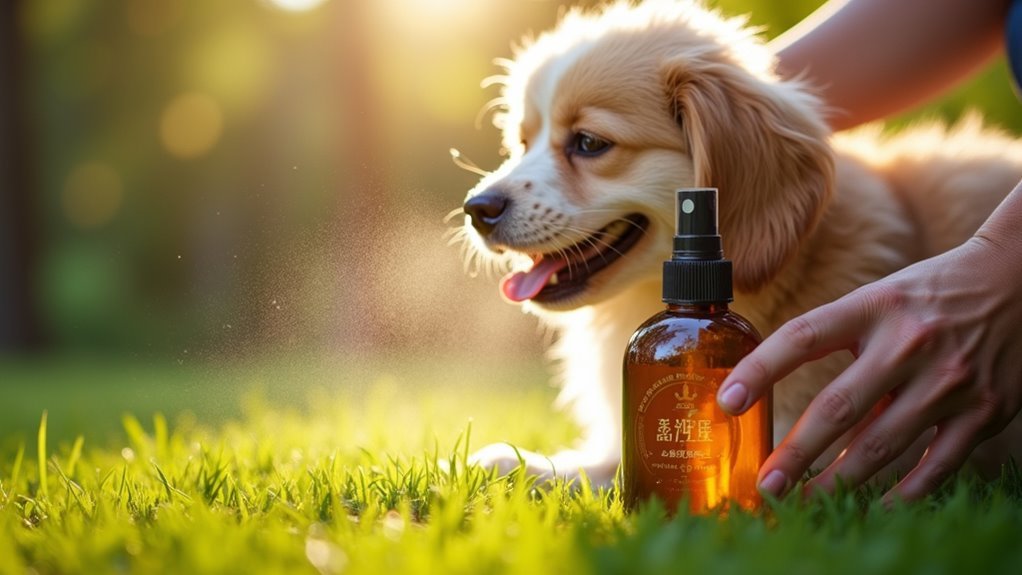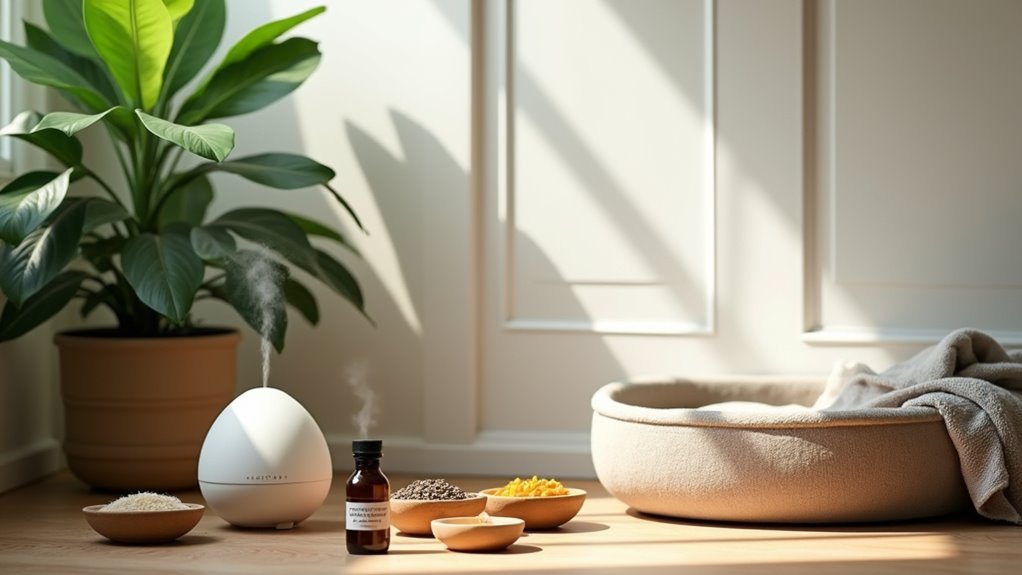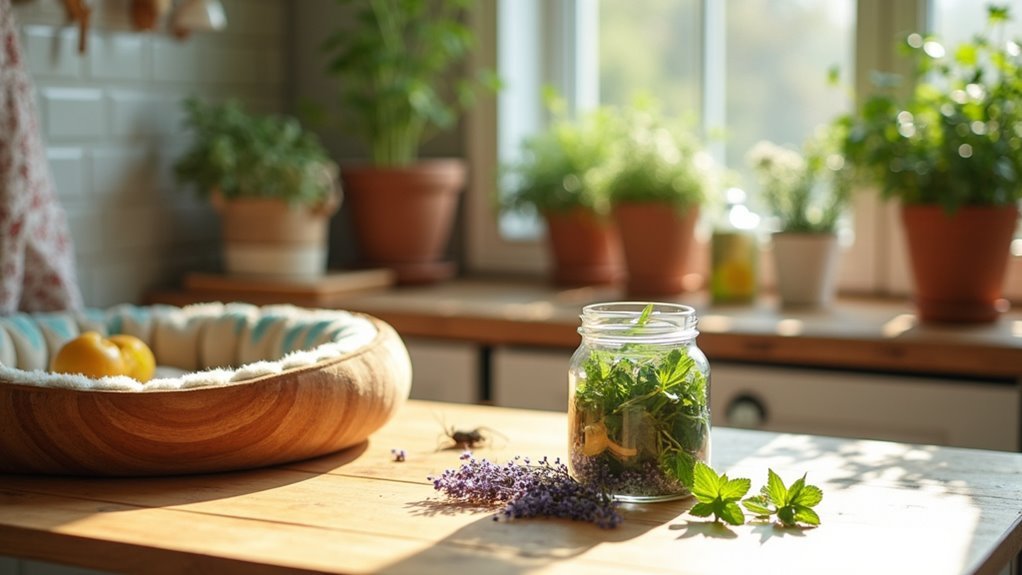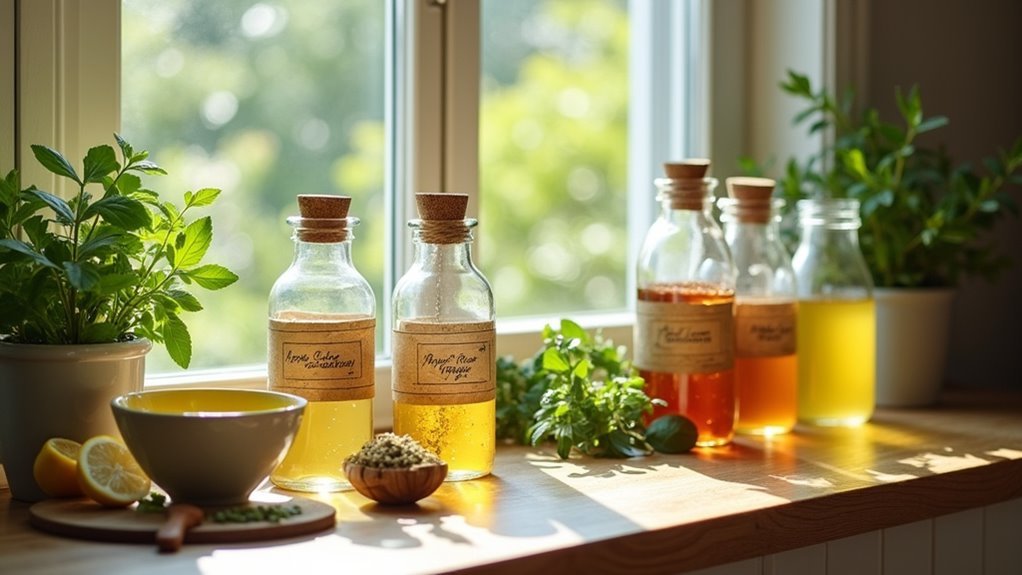You can create an effective natural flea spray using equal parts white or apple cider vinegar and water. The vinegar’s high acidity repels fleas while disrupting their life cycle by preventing egg hatching. Simply mix the solution in a spray bottle and apply directly to carpets, pet bedding, and upholstery where fleas congregate. For enhanced protection, add essential oils like peppermint or lavender. This chemical-free alternative provides lasting protection when applied consistently and proves safer for both pets and your family than harsh commercial pesticides.
Why Vinegar Works Against Fleas and Ticks

When you’re searching for a safe yet effective flea control method, vinegar stands out as one of nature’s most powerful weapons against these persistent pests.
This natural flea repellant works through its strong scent and high acidity levels, which fleas find extremely unappealing. The acetic acid content doesn’t just repel – it can eliminate fleas on contact while creating an environment that’s hostile to their survival.
Vinegar’s potent acetic acid content creates a dual-action defense system that both repels existing fleas and eliminates them upon direct contact.
What makes vinegar particularly effective is its ability to disrupt the flea life cycle by preventing eggs from hatching.
This chemical-free alternative offers you a cost-effective solution that’s safer for your pets and environment compared to commercial treatments.
When incorporated into your regular pest management routine, vinegar creates lasting protection that keeps fleas from returning.
Essential Ingredients for Effective Vinegar Spray
You’ll need to choose between distilled white vinegar or apple cider vinegar as your base ingredient, as both work effectively against fleas.
Mix your selected vinegar with equal parts water to create the proper dilution ratio that won’t damage surfaces while maintaining flea-repelling properties.
Apply the solution by spraying directly onto infested areas, then wipe with a cloth soaked in the mixture for better penetration and maximum effectiveness.
Vinegar Type Selection
Two types of vinegar stand out as the most effective choices for your natural flea spray: distilled white vinegar and apple cider vinegar. Both contain acetic acid that disrupts flea behavior and creates an environment fleas can’t tolerate. The strong smell alone is enough to repel these pests from treated areas.
You’ll want to dilute your chosen vinegar with water using a 1:1 ratio for maximum effectiveness. This mixture won’t damage surfaces or irritate your pet’s skin like undiluted vinegar might.
Apply this solution to problem areas where fleas hide, including pet bedding, carpets, and upholstery. The acetic acid content makes both vinegar types equally effective, so choose based on availability and personal preference for this inexpensive, natural flea control method.
Proper Dilution Ratios
Creating the perfect vinegar flea spray starts with getting your dilution ratios exactly right.
You’ll want to mix equal parts distilled white vinegar and water in a spray bottle for maximum effectiveness. This 1:1 ratio provides the perfect balance to repel fleas without being too harsh on surfaces.
To boost your vinegar solution’s power, add a few drops of essential oils like peppermint or lavender. These natural oils enhance the flea-repelling properties considerably.
Apply your flea spray to carpets, pet bedding, and furniture where fleas typically hide, ensuring surfaces are lightly dampened but not soaked.
The best part? Your homemade spray is safe to use around pets and children.
Test a small area first, then apply every few days to break the flea lifecycle effectively.
Application Technique Tips
Now that you’ve mastered the proper dilution ratios, your application technique can make or break your flea control efforts. Before using your natural flea spray broadly, always test for colorfastness on an inconspicuous area. Apply a small amount to fabrics and surfaces, waiting to verify no discoloration occurs.
Target areas where fleas congregate: carpets, pet bedding, and upholstery. Spray thoroughly but don’t oversaturate. For best results, maintain consistent application schedules. Regular use helps disrupt the flea lifecycle effectively, preventing eggs from hatching and deterring adult fleas.
Consider enhancing your spray with citrus juice for added potency. This natural flea spray becomes more effective against pests when applied systematically rather than sporadically, verifying complete coverage of infested areas.
Step-by-Step Recipe for Homemade Vinegar Flea Spray
Creating an effective vinegar flea spray requires precise mixing ratios to guarantee maximum potency without damaging your home’s surfaces.
You’ll need to combine equal parts distilled white vinegar and water in a clean spray bottle, creating a balanced solution that repels fleas while remaining safe for most household materials.
Before applying this mixture throughout your home, it’s essential to test the solution on inconspicuous areas to prevent potential discoloration or damage to fabrics and furniture.
Ingredient Mixing Ratios
Most homemade vinegar flea sprays require just two primary ingredients in equal proportions: distilled white vinegar and water. This simple 1:1 ratio creates an effective natural repellent that fleas can’t stand.
You’ll mix equal amounts of distilled white vinegar with water in your spray bottle – for example, one cup of each ingredient works perfectly for most applications.
To boost your flea spray’s effectiveness, add 3-5 drops of essential oils like rosemary or peppermint per cup of mixture. These oils enhance the repellent properties while providing a pleasant scent.
Always test this solution on a small area first, especially when using it around pets, as some animals may show sensitivity to vinegar-based products.
Application Safety Tips
Before applying your vinegar flea spray, you’ll need to follow essential safety precautions to protect both your family and pets.
Always apply a small amount to test a small inconspicuous area first, checking for colorfastness and potential damage to fabrics or surfaces.
This natural flea spray works effectively when you apply the surface uniformly across pet bedding, carpets, and furniture.
Avoid direct contact with pets’ skin, as vinegar can cause irritation.
When using the spray for indoor and outdoor applications, guarantee proper ventilation and keep children away from treated areas until dry.
Regular application will help reduce the occurrence of flea infestations when combined with thorough pest management strategies.
Proper Application Techniques for Maximum Results

While natural flea sprays offer a safer alternative to chemical treatments, their effectiveness depends heavily on how you apply them. The best spray for dogs requires proper technique to maximize results. Always shake well before use to distribute active ingredients evenly. Apply the product strategically, focusing on your pet’s belly, legs, and tail where fleas commonly hide.
| Application Area | Technique | Key Point |
|---|---|---|
| Pet’s Coat | Light, even coverage | Avoid soaking |
| Home Surfaces | Mist until moist | Test for staining |
| Reapplication | Every 24 hours | Continuous protection |
| Drying Time | Clear area of pets | Wait until completely dry |
Remember to avoid soaking your pet’s fur, as this reduces effectiveness. For cats, apply to hands first for safe and effective treatment. Reapply daily for maximum flea control.
Safety Considerations for Pets and Family Members
Even though natural flea sprays contain safer ingredients than chemical alternatives, you’ll still need to take important precautions to protect your pets and family members.
Before widespread use, test a small coat area for sensitivity reactions. Verify the spray’s safe for your specific pet type, as certain ingredients like peppermint oil can harm cats.
When treating indoor spaces, apply the spray in a well-ventilated area while pets and family are away until it dries completely.
Always follow manufacturer’s instructions regarding dosage and frequency. After application, monitor pets closely for discomfort or adverse reactions.
These safety considerations guarantee effective flea control without compromising anyone’s health. Consult your veterinarian immediately if problems arise.
Enhancing Your Spray With Natural Essential Oils

Beyond following basic safety protocols, you can considerably boost your natural flea spray’s effectiveness by incorporating specific plant-based oils that fleas naturally avoid.
Natural essential oils like Cedarwood, Lemongrass, Rosemary, and Peppermint deliver powerful pest-repelling properties without harsh chemicals. Cedarwood oil particularly excels at deterring fleas while creating a pleasant aroma.
Combining multiple oils amplifies your spray’s potency since each targets different pest vulnerabilities. You’ll want to use these oils at safe therapeutic rates—effective enough to repel pests while preventing pet irritation.
The bonus? These oils make your spray smell amazing for both you and your pets.
For continuous protection against fleas, ticks, and mosquitoes, reapply your enhanced spray every 24 hours to maintain peak effectiveness.
Treating Different Surfaces and Areas of Your Home
Three key factors determine your natural flea spray’s success: proper surface preparation, correct application technique, and strategic area targeting. Before treating any fabric surfaces, test a small inconspicuous area to verify colorfastness. Apply the spray lightly to pet bedding, carpets, and upholstery until surfaces are moist but not soaked.
| Surface Type | Application Method | Coverage Area |
|---|---|---|
| Carpets | Spray the surface uniformly | 400 sq ft per 32 oz |
| Pet Bedding | Light, even application | Multiple items per bottle |
| Upholstery | Test first, then treat | Varies by furniture size |
Your Natural Flea and Tick treatment works both indoors and outdoors. Complement spraying with regularly vacuuming and steam cleaning to remove eggs and larvae. This combination will effectively kill fleas while preventing reinfestation throughout your home.
Long-Term Prevention Strategies With Vinegar Solutions
While immediate flea treatment addresses current infestations, vinegar solutions offer an economical approach for ongoing prevention that’ll keep these pests from returning.
This natural pest control method requires consistent effort but delivers lasting results when integrated into your household routine.
Essential long-term prevention strategies include:
- Weekly surface treatments – Spray vinegar solutions on carpets, upholstery, and pet bedding areas where fleas typically hide and reproduce.
- Integration with cleaning routines – Combine regular application of your flea repellant with thorough vacuuming to disrupt flea lifecycles effectively.
- Comprehensive property maintenance – Maintain yard hygiene and establish consistent pet grooming schedules alongside your vinegar treatments.
Regular application of these cost-effective solutions helps prevent infestations before they start, making long-term prevention both achievable and affordable for any household.
Frequently Asked Questions
What Is the Best Natural Thing to Kill Fleas?
You’ll find diatomaceous earth works best for killing fleas naturally. It dehydrates them effectively without harmful chemicals. You can also use essential oil sprays with cedarwood or rosemary for quick contact kills.
What Homemade Spray Gets Rid of Fleas?
You’ll want to mix equal parts distilled white vinegar and water in a spray bottle. This homemade solution effectively repels fleas since they can’t stand vinegar’s strong smell and taste.
What Kills 100% of Fleas?
No single method kills 100% of fleas instantly. You’ll need a multi-pronged approach combining professional-grade treatments, diatomaceous earth, essential oil sprays, thorough vacuuming, and washing all fabrics in hot water.
What Do Fleas Hate the Most on Humans?
You’ll find that fleas hate strong scents on your skin most. They’re repelled by essential oils like lavender, peppermint, and cedarwood, plus citrus scents and vinegar’s odor disrupting their sensory receptors.
In Summary
You’ve now got everything you need to create an effective, natural flea spray that’ll protect your home and pets without harsh chemicals. Remember, consistency’s key—apply your vinegar solution regularly and treat all areas where fleas might hide. Don’t forget to vacuum frequently and wash pet bedding to support your spray’s effectiveness. With patience and persistence, you’ll eliminate those pesky fleas while keeping your family safe from toxic pesticides.





Leave a Reply